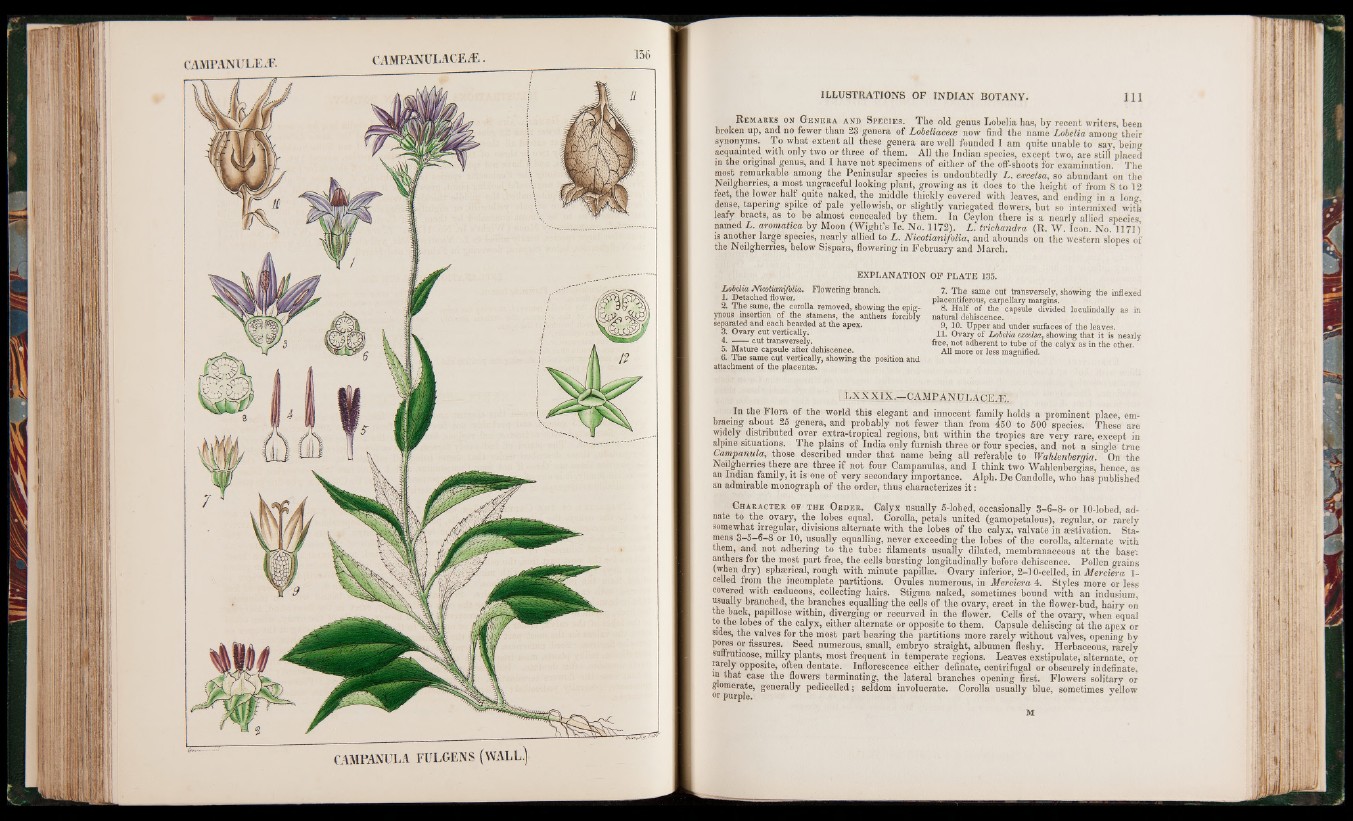
CAMPANULACEÆ.
CAMPANULA FULGENS (WALL.)
R emarks on Genera and Species. The old genus Lobelia has, by recent writers, been
broken up, and no fewer than 23 genera of Lobeliaoeai now find the name Lobelia among their
synonyms. To what extent all these genera are well founded I am quite unable to say, being
acquainted with only two or three of them. All the Indian species, except two, are still placed
in the original genus, and I have not specimens of either of the off-shoots for examination. The
most remarkable among the Peninsular species is undoubtedly L. excelsa, so abundant on the
Neilghemes, a most ungraceful looking plant, growing as it does to the height of from 8 to 12
feet, the lower half quite naked, the middle thickly covered with leaves, and ending in a long,
dense, tapering spike of pale yellowish, or slightly variegated flowers, but so intermixed with
leafy bracts, as to be almost concealed by them. In Ceylon there is a nearly allied species
named L. aromatica lly Moon (Wight’s Ic. No. 1172). L. trichandra (R. W. Icon. No. 1171V
is another large species, nearly allied to L. Nicotianifolia, and abounds on the western slopes of
the Neilgherries, below Sispara, flowering in February and March.
EXPLANATION OP PLATE 135.
Lobelia Nicotianifolia. Flowering branch.
1. Detached flower.
2. The same, the corolla removed, showing the epig-
ynous insertion of the stamens, the anthers forcibly
separated and each bearded at the apex.
3. Ovary cut vertically.
4 . --------------------- cut transversely.
5. Mature capsule after dehiscence.
6. The same cut vertically, showing the position and
attachment of the placentae.
7. The same cut transversely, showing the inflexed
placentiferous, carpellary margins.
8. Half of the capsule divided loculindally as in
natural dehiscence.
9. 10. Upper and under surfaces of the leaves.
11. Ovary of Lobelia excdsa, showing that it is nearly
free, not adherent to tube of the calyx as in the other.
All more or less magnified.
LXXXIX.—CAMPANULACEyE.
In the Flora of the world this elegant and innocent family holds a prominent place, embracing
about 25 genera, and probably not fewer than from 450 to 500 species. These are
widely distributed over extra-tropical regions, but within the tropics are very rare, except in
alpine situations. The plains of India only furnish three or four species, and not a single true
Campanula, those described under that name being all referable to Wahlenbergia. On the
Neilgherries there are three if not four Campanulas, and I think two Wahlenbergias, hence, as
an Indian family, it is one of very secondary importance. Alph. De Candolle, who has published
an admirable monograph of the order, thus characterizes i t :
Character of the Order. Calyx usually 5-Iobed, occasionally 3-6-8- or 10-lobed, ad-
nate to the ovary, the lobes equal. Corolla, petals united (gamopetalous), regular, or rarely
somewhat irregular, divisions alternate with the lobes of the calyx, valvate in aestivation. Stamens
3-5-6-8 or 10, usually equalling, never exceeding the lobes of the corolla, alternate with
them, and not adhering to the tube: filaments usually dilated, membranaceous at the base':
anthers for the most part free, the cells bursting longitudinally before dehiscence. Pollen grains
(when dry) sphaerical, rough with minute papillae. Ovary inferior, 2-10-celled, in Merciera 1 -
celled from the incomplete partitions; Ovules numerous, in Merciera 4. Styles more or less
covered with caducous, collecting hairs. Stigma naked, sometimes bound with an indusium,
usumly branched, the branches equalling the cells of the ovary, erect in the flower-bud, hairy on
the back, papillose within, diverging or recurved in the flower. Cells of the ovary, when equal
to the lobes of the calyx, either alternate or opposite to them. Capsule dehiscing at the apex or
sides, the valves for the most part bearing the partitions more rarely without valves, opening by
° f fissures. Seed numerous, small, embryo straight, albumen fleshy. Herbaceous, rarely
suftruticose, milky plants, most frequent in temperate regions. Leaves exstipulate, alternate, or
rarely opposite, often dentate. Inflorescence either definate, centrifugal or obscurely indefinate,
in that case the flowers terminating, the lateral branches opening first. Flowers solitary or
gomerate, generally pedicelled; seldom involucrate. Corolla usually blue, sometimes yellow
nr purple. J
M